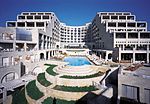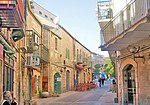Mamilla Pool

Mamilla Pool (also known as Birket Mamilla) is one of several ancient reservoirs that supplied water to the inhabitants of the Jerusalem. It is located outside the walls of the Old City about 650 metres (710 yd) northwest of Jaffa Gate in the centre of the Mamilla Cemetery. With a capacity of 30,000 cubic metres, it is connected by an underground channel to Hezekiah's Pool in the Christian Quarter of the Old City. It was thought as possible that it has received water via the so-called Upper or High-Level Aqueduct from Solomon's Pools, but 2010 excavations have discovered the aqueduct's final segment at a much lower elevation near the Jaffa Gate, making it impossible to function as a feeding source for the Mamilla Pool.
Excerpt from the Wikipedia article Mamilla Pool (License: CC BY-SA 3.0, Authors, Images).Mamilla Pool
Agron, Jerusalem Nahalat Shiva
Geographical coordinates (GPS) Address External links Nearby Places Show on map
Geographical coordinates (GPS)
| Latitude | Longitude |
|---|---|
| N 31.777777777778 ° | E 35.220555555556 ° |
Address
בריכת ממילא
Agron
9419008 Jerusalem, Nahalat Shiva
Jerusalem District, Israel
Open on Google Maps











